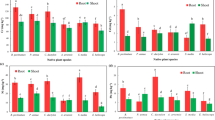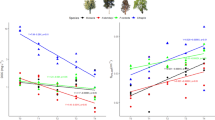Abstract
Attention is being focused on the coastline from Doha to Ras Laffan in Qatar since higher activities in the development of land and establishment of roads, highways and new buildings and houses is not coupled by serious studies on habitat destruction, fragmentation or disturbances. Ecophysiological study was carried out to investigate the adaptation of two halophytes (Limonium axillare and Avicennia marina) in this area, with special emphasis on the ultrastructure of salt glands found in the leaves. Soils in these locations accumulated much Na+ and Cl− as compared to other cations like K+, Ca2+ and Mg2+. Both plants accumulated higher concentrations of Na+ , Cl−, and Ca2+ and lower concentrations of K+ and Mg2+. Organic compounds found in leaves of these plants under their natural habitats including proline, soluble sugars and nitrogen, and photosynthetic pigments were determined. Scanning electron micrographs of the surface of leaves showed that salt glands of these plants are well developed. It is urgently required that exact vegetation maps, and monitoring exercises will be conducted, in order to document exactly the state of the vegetation in Qatar. Only this will allow the environment authorities to bring forward suggestions for vegetation and ecosystem management to the decision makers.












Similar content being viewed by others
References
Abdel-Bari EM Yasseen BT (2004) Restoration of a coastline vegetation. Ras Laffan Company, sponsored by SARC, University of Qatar, Doha, Qatar
Abdel-Bari EM Yasseen BT, Al-Thani RF (2007) Halophytes in the State of Qatar. Environmental Studies Center. University of Qatar, Doha, Qatar
Abulfatih HA, Abdel-Bari EM, Alsubaey A, Ibrahim YM (2001) Vegetation of Qatar. Scientific and Applied Research Center (SARC), University of Qatar, Doha, Qatar
Adam P (1993) Saltmarsh ecology. Cambridge University Press
Al-Easa HS, Rizk, AM, Abdel-Bari EM (2003) Chemical constituents and nutritive values of range plants in Qatar. Scientific and Applied research Center, University of Qatar, Doha, Qatar
Alhadi FA, Yasseen BT, Al-Dubaie AS (1997) Changes in carbohydrate and nitrogen fractions during germination of fenugreek (Trigonella foenum-graecum L.) seeds presoaked in GA3, growing under different osmotic potentials. Qatar Univ Sci J 17:271–279
Alhadi FA, Yasseen BT, Jabr M (1999) Water stress and gibberellic acid effects on growth of fenugreek plants. Irrig Sci 18:185–190, doi:10.1007/s002710050061
Ashore MM (1991) Sabkhas in the peninsula of Qatar – geomorphologic and geological and biological studies – University of Qatar. Centre of Documentation and Humanitarian Studies, Doha, Qatar
Ashraf M, Foolad MR (2007) Roles of glycinebetaine and proline in improving plant abiotic resistance. Environ Exp Bot 59(2):206–216, doi:10.1016/j.envexpbot.2005.12.006
Bates LS, Wadleigh RP, Teare ID (1973) Rapid determination of free proline for water-stress studies. Plant Soil 39:205–207, doi:10.1007/BF00018060
Bengtson C, Klockare B, Klockare R, Larsson S, Sundqvist C (1987) The after-effect of water stress on chlorophyll formation during greening and the level of abscisic acid and proline in dark grown wheat seedlings. Physiol Plant 43:205–212, doi:10.1111/j.1399-3054.1978.tb02565.x
Böer B, Al-Hajiri S (2002) The coastal and sabkha flora of Qatar: An introduction. In: Barth HJ, Böer B (eds) Sabkha ecosystems vol.: the Arabian peninsula and adjacent countries. Tasks for vegetation science 36. Kluwer Academic Publishers, The Netherlands, pp 63–70
Chapman HD, Pratt PF (1961) Methods of analysis for soils, plants and waters. Div Agr Sci Univ Calif Berkeley, California
Chen TH, Murata N (2002) Enhancement of tolerance of abiotic stress by metabolic engineering of betaines and other compatible solutes. Curr Opin Plant Biol 5(3):250–257, doi:10.1016/S1369-5266(02)00255-8
Downton WJS (1982) Growth and osmotic relations of the mangrove (Avicennia marina) as influenced by salinity. Aust J Plant Physiol 9(5):519–528
Flowers TJ (1985) Physiology of halophytes. Plant Soil 89:41–56, doi:10.1007/BF02182232
Flowers TJ (2004) Improving crop salt tolerance. J Exp Bot 55(396):307–319, doi:10.1093/jxb/erh003
Flowers TJ, Yeo AR (1986) Ion relations of plants under drought and salinity. Aust J Plant Physiol 13:75–91
Fukuda A, Yazaki YT, Ishikawa S, Koike T, Tanaka Y (1998) Na+ /H+ antiporter in tonoplast vesicles from rice roots. Plant Cell Physiol 39:196–201
Glenn EP (1997) Mechanisms of salt tolerance in higher plants. In: Basra AS, Nasra RK (eds) Mechanisms of environmental stress resistance in plants. Harwood Academic Publishers, Amsterdam, pp 83–110
Greenway H, Munns R (1980) Mechanisms of salt tolerance in nonhalophytes. Annu Rev Plant Physiol 31:149–190, doi:10.1146/annurev.pp.31.060180.001053
Hasegawa PM, Bressan RA, Zhu J-K, Bohnert HJ (2000) Plant cellular and molecular responses to high salinity. Annu Rev Plant Physiol Plant Mol Biol 51:463–499, doi:10.1146/annurev.arplant.51.1.463
Hogarth PJ (1999) The biology of mangroves. Oxford University Press, New York
Kavi Kishor PB, Sangam S, Amrutha RN, Sri Laxmi P, Naidu KR, Rao KRSS, Rao S, Reddy KJ, Theriappan P, Sreenivasulu N (2005) Regulation of proline biosynthesis, degradation, uptake and transport in higher plants: its implications in plant growth and abiotic stress tolerance. Curr Sci 88(3):424–438
Larcher W (2003) Physiological plant ecology. Eco-physiology and stress physiology of functional groups, 4th edn. Springer, Berlin
Levitt J (1980) Responses of plants to environmental stresses. II. Water, radiation, salt and other stresses, 2nd edn. Academic, New York
Metzner H, Rau H, Senger H (1965) Untersuchungen zur synchronisierbarkeit einzelner pigmentmangel – mutanten von Chlorella. Planta 65:186–194, doi:10.1007/BF00384998
Nilsen ET, Orcutt DM (1996) Physiology of plants under stress. Abiotic factors. Wiley, New York
Orcutt DM, Nilsen ET (2000) Physiology of plants under stress. Soil and biotic factors. Wiley, New York
Paleg LG, Aspinall D (1981) The physiology and biochemistry of drought resistance in plants. Academic, Sydney
Rhodes D, Hanson AD (1993) Quaternary ammonium and tertiary sulfonium compounds in higher plants. Annu Rev Plant Physiol Plant Mol Biol 44:357–384, doi:10.1146/annurev.pp.44.060193.002041
Richer R (2008) Conservation in Qatar: Impacts of Increasing Industrialization. Center for International and Regional Studies (CIRS). Georgetown University, School of Foreign Service in Qatar
Saenger P (2002) Mangrove Ecology, Silverculture and Conservation. Kluwer Academic Publishers, Dordrecht
Taiz L, Zeiger E (2006) Plant physiology. Redwood City, California
Tomlinson PB (1986) The botany of mangrove. Cambridge University Press, New York
Vassilyev AE, Stepanova AA (1990) The ultrastructure of ion-secreting and non-secreting salt glands of Limonium platyphyllum. J Exp Bot 41:41–46, doi:10.1093/jxb/41.1.41
Yasseen BT (2001) Preliminary assessment of the effect of saline water used in irrigation on the growth of the local barley cultivar (Harma). Qatar Univ Sci J 21:55–64
Yasseen BT, Al-Thani RF (2007) Halophytes and associated properties of natural soils in the Doha area, Qatar. AEHMS 10:320–326
Yeo AR (1983) Salinity resistance: physiologies and prices. Physiol Plant 58:214–222, doi:10.1111/j.1399-3054.1983.tb04172.x
Youssef AM, Hassanein RA, Hassanein AA, Morsy AA (2003) Changes in quaternary ammonium compounds, proline and protein profiles of certain halophytic plants under different habitat conditions. Pak J Biol Sci 6(10):867–882
Acknowledgment
The authors would like to thank Environmental Studies Center, Qatar University, for the financial support, and Al-al-Bayt University for facilitating publishing this work.
Author information
Authors and Affiliations
Corresponding author
Rights and permissions
About this article
Cite this article
Yasseen, B.T., Abu-Al-Basal, M.A. Ecophysiology of Limonium axillare and Avicennia marina from the coastline of Arabian Gulf-Qatar. J Coast Conserv 12, 35–42 (2008). https://doi.org/10.1007/s11852-008-0021-z
Received:
Revised:
Accepted:
Published:
Issue Date:
DOI: https://doi.org/10.1007/s11852-008-0021-z




